A Multi-Methodological Exploration of Persecution Experiences and Related Injuries of Sexually Minoritized Asylum Seekers and Refugees in Nairobi, Kenya
Abstract
1. Introduction
2. Methods
2.1. Study Design
2.2. Sampling and Recruitment
2.3. Participants
2.4. Data Collection
2.5. Data Analysis
3. Results
3.1. Anti-Homosexuality Act
“… I think the bill [Anti-Homosexuality Act] was already signed. So, it was trending everywhere. It was the talk of the church and the mosque in the testimony and something some people used in campaigns. So, this bill, however much it was nullified later, it had already harmed people. Because some people had in their minds that gay people are supposed to be killed”.(Participant 17, 24 years)
“… Let us say one of the things that led to my fleeing the country was their signing of the bill. It led the communities to be more homophobic towards us. They [unknown community members] would randomly kill gay people if they found us on the streets. We were taken to be like chickens to be killed anyhow [without regard for life]. After signing the bill, we tried to live in hiding. However, strangers beat my partner and friend. I managed to escape… but that is the last time I remember seeing my partner and my friend.”
3.2. Death Punishment
“I had to run from home. I knew they were coming and what would happen to me. Because where I come from, death is the only punishment when they know you are gay or belong to any LGBT group! If not peeling your skin off… and what was to be done to me to punish me, and when they punish me, it was to be death. The government was aware of that and gave powers to kill whoever is gay or lesbian or any queer person.”(Participant 12, 22 years old)
“When I used to see [gay] people being killed for expressing their orientation, expressing themselves who they are, their truth of who they are. Someone because of love is crucified or even killed, do not even know, like a snake. Because after a snake is killed, it is thrown in the bush, and no one cares. That is how someone was killed or when they found out he is gay.”
3.3. Physical Violence
“I lived in the camp for like for one year and something. There [Kakuma], we were harassed, and people were abusing us, that we are LGBTI [Lesbian, Gay, Bisexual, Transgender, and Intersex]. At times even they were like, they wanted just to kill us. So, I decided to leave and come to Nairobi. So UNHCR agreed to transfer my data to Nairobi.”
“I went to the police. What happened there, heeeeeei! I told the police officer what had happened. They told me, hmm, I left Uganda to do those things [same-gender attraction] here [Kenya]. You people, you are the ones destroying our children here in Nairobi. Every police officer came to see me and abused me. I was ashamed. I said I would never go back to where I will report anything to the police concerning this. I felt terrible!”
“…Sometime back, the police came to our house… They wanted to know why we were more than five or six people in the same house. We were arrested and stayed at Kikuyu police station for four days as they were doing their investigations. Until the United Nations High Commission for refugees learned that we were in cells, they were the ones who came and bailed us out, and then we were brought back home.”Participant 6 (41 years old)
3.4. Sexual Violence
“So, the man raped me! Raped me! I will never forget when I think of these things in my life. It has become so difficult to understand… The man raped me for the first time. He raped me when he was alone. And then from that day, he told me that thing we had done was gonna be continuous, and I should not go anywhere outside the tent… Others also started raping me. They started coming out like three people or two who were drunk, and they raped me—all of them. I was there from when I was 14 years [old] until 15 years [old]. I spent one good year passing through those things there, yet I was looking for a way to take myself out of the country.”(Participant 8, 21 years old)
“At first, I did not know why they were calling me there, and because I was new, I did not know anything about being in prison... two guys entered the room with me. They were four; one remained on the door. I entered with two. Then we found another one inside. When I entered, he grabbed my hand. Another one grabbed my legs. Then they pushed me to the floor. Then, one guy came on me then said, I need to have sex with you, and I was like, no. They then said, we already know you are gay; we will kill you. That is what he mentioned. And then he started, of course, raping me, and I felt so bad. It was a terrible experience for me. Furthermore, when the second one came, he released as he was trying to penetrate me, then the rest of the two said no-no for us; we will not do that, let him go.”
3.5. Discrimination
“… He did not pay me the right amount. He used to delay and all that. So, after three months of working without payment, I went to the police to report… So, the police were like, do you have a work permit? I said no, but we had agreed. I had a copy of what we had agreed on, and we agreed he would pay me this, and he said he was OK with that. How do you say it is OK with it? Like whom gives you, who gave you the right to work? You are a refugee; you are not supposed to work. That was a bummer! They did not give me my money, and the police did nothing about it.”(Participant 16, 24 years)
“Like my partner, you will get a job in Westlands [a neighborhood in Nairobi]. You know there is a minimum wage where you are supposed to earn a wage. Where you are supposed to earn five hundred, they will be delighted and willing to take you to earn two hundred Kenya shillings daily. Desperate or not desperate, you have no choice. While your colleagues earn five hundred, you earn two hundred shillings, working twice as hard as those. This amounts to exploitation, so eventually, people are run down.”(Participant 2, 35 years)
3.6. Injuries
“I was in one of the parks. It is called Mama Ngina. Just knowing your nationality, someone boxed [beat] me hard. The way I was kicked injured my private parts [groin]. I had to have surgery. I later wrote UNHCR asking for medication. They said I should buy the medicine because I am in an urban area. I explained to them that I did not even have money to cater for my medication… even to buy painkillers, to go to government hospital sometime, they ask for I.D., once you fluke, you get the painkillers, which are not enough.”
“About twelve people saw my boyfriend and me kissing and hit me with a stone on my head. Later, the police took us to the hospital. So, they stitched the wound, and all this part [left front] of my head is a bit paralyzed from that time till now. Whenever I touch it, I do not feel anything around the scar. It also reminds me that I was with my boyfriend and beaten because of being gay. Sometimes I try to forget everything, but this scar reminds me of what happened. I feel so bad. I feel bad because there was a possibility that it could have affected my brain, and I could have died. I am also terrified because I feel like the next thing that will happen to me is that I will be dead! So, I am always scared of that.”(Participant 6, 41 years)
4. Discussion
4.1. Physical Violence
4.2. Sexual Violence
4.3. Discrimination
4.4. Injuries
5. Limitations and Strengths
6. Conclusions
Author Contributions
Funding
Institutional Review Board Statement
Informed Consent Statement
Data Availability Statement
Acknowledgments
Conflicts of Interest
References
- Tamale, S. Exploring the contours of African sexualities: Religion, law, and power. Afr. Hum. Rights Law J. 2014, 14, 150–177. [Google Scholar]
- Caroll, A.; Itaborahy, L. State-sponsored homophobia. A World Surv. Laws Crim. Prot. Recognit. Same-Sex Love. 11th Edition. Available online: https://ilga.org/downloads/02_ILGA_State_Sponsored_Homophobia_2016_ENG_WEB_150516.pdf (accessed on 12 July 2019).
- Wahab, A. “Homosexuality/homophobia is un-African”?: Un-mapping transnational discourses in the context of Uganda’s anti-homosexuality bill/act. J. Homosex. 2016, 63, 685–718. [Google Scholar] [CrossRef] [PubMed]
- Strand, C. Kill bill! Ugandan human rights organizations’ attempts to influence the media’s coverage of the anti-homosexuality bill. Cult. Health Sex. 2011, 13, 917–931. [Google Scholar] [CrossRef] [PubMed]
- Moore, H.K. “The atmosphere is oppressive”: Investigating the intersection of violence with the cisgender lesbian, bisexual, and queer women refugee community in Nairobi, Kenya. In LGBTI Asylum Seekers and Refugees from a Legal and Political Perspective; Springer: Berlin/Heidelberg, Germany, 2019; pp. 323–336. [Google Scholar]
- Allsopp, J.; Sigona, N.; Phillimore, J. Poverty among Refugees and Asylum Seekers in the UK: An Evidence and Policy Review; The University of Birmingham, Institute for Research into Superdiversity: Birmingham, UK, 2014. [Google Scholar]
- Alessi, E.J.; Kahn, S.; Van Der Horn, R. A qualitative exploration of the premigration victimization experiences of sexual and gender minority refugees and asylees in the United States and Canada. J. Sex Res. 2017, 54, 936–948. [Google Scholar] [CrossRef]
- McMichael, C.; Nunn, C. Conducting health research with resettled refugees in Australia: Field sites, ethics, and methods. In The Health of Refugees: Public Health Perspectives from Crisis to Settlement; Oxford University Press: Oxford, UK, 2019; Chapter 12. [Google Scholar]
- United Nations High Commissioner for Refugees (UNHCR). Protecting Persons with Diverse Sexual Orientations and Gender Identities; UNHCR: Geneva, Switzerland, 2015. [Google Scholar]
- Alessi, E.J.; Kahn, S. A framework for clinical practice with sexual and gender minority asylum seekers. Psychol. Sex. Orientat. Gend. Divers. 2017, 4, 383. [Google Scholar] [CrossRef]
- King, R.; Barker, J.; Nakayiwa, S.; Katuntu, D.; Lubwama, G.; Bagenda, D.; Lane, T.; Opio, A.; Hladik, W. Men at Risk; a qualitative study on HIV risk, gender identity, and violence among men who have sex with men who report high-risk behavior in Kampala, Uganda. PLoS ONE 2013, 8, e82937. [Google Scholar] [CrossRef]
- Anyamele, C.; Lwabaayi, R.; Nguyen, T.; Binswanger, H. Sexual minorities, violence and AIDS in Africa. World Bank Afr. Reg. Work. Pap. Ser. 2005, 84, 2–11. [Google Scholar]
- Hladik, W.; Sande, E.; Berry, M.; Ganafa, S.; Kiyingi, H.; Kusiima, J.; Hakim, A. Men who have sex with men in Kampala, Uganda: Results from a bio-behavioral respondent-driven sampling survey. AIDS Behav. 2017, 21, 1478–1490. [Google Scholar] [CrossRef]
- Misedah, L.; Ross, M.; Wambua, S.; Schick, V. The mental health of male sexual minority asylum seekers and refugees in Nairobi, Kenya: A qualitative assessment. Refug. Can. J. Refug. 2022, 38, 1. [Google Scholar] [CrossRef]
- Hopkinson, R.A.; Keatley, E.; Glaeser, E.; Erickson-Schroth, L.; Fattal, O.; Nicholson Sullivan, M. Persecution experiences and mental health of LGBT asylum seekers. J. Homosex. 2017, 64, 1650–1666. [Google Scholar] [CrossRef]
- Misedah, L. A Qualitative Assessment of Persecution Experiences and Health Needs of Sexual Minority Asylum Seekers and Refugees in Nairobi, Kenya; The University of Texas, School of Public Health: Houston, TX, USA, 2021. [Google Scholar]
- Alessi, E.J. Resilience in sexual and gender minority forced migrants: A qualitative exploration. Traumatology 2016, 22, 203. [Google Scholar] [CrossRef]
- Etikan, I.; Musa, S.A.; Alkassim, R.S. Comparison of convenience sampling and purposive sampling. Am. J. Theor. Appl. Stat. 2016, 5, 1–4. [Google Scholar] [CrossRef]
- McAdams, D.P. The Life Story Interview; Northwestern University: Evanston, IL, USA, 2008. [Google Scholar]
- Foster-Fishman, P.; Mortensen, J.; Berkowitz, S.; Nowell, B.; Lichty, L. Photovoice: Using Images to Tell Communities’ Stories: Participants Handbook; Systems Exchange, Michigan State University: East Lansing, MI, USA, 2013; p. 20. Available online: http://systemexchange.msu.edu/upload/Photovoice (accessed on 16 September 2019).
- Glaser, B.; Strauss, A. The Discovery of Grounded Theory; Aldine Publishing Company: Hawthorne, NY, USA, 1967. [Google Scholar]
- Morse, J.M. Designing funded qualitative research. In Handbook of Qualitative Research; Denzin, N.K., Lincoln, Y.S., Eds.; SAGE Publications, Inc.: Newbury Park, CA, USA, 1994; pp. 220–235. [Google Scholar]
- Braun, V.; Clarke, V. Using thematic analysis in psychology. Qual. Res. Psychol. 2006, 3, 77–101. [Google Scholar] [CrossRef]
- Lincoln, Y.E. Naturalistic inquiry. Beverly Hills: Sage master, peter (1999) editorial. Engl. Specif. Purp. 1985, 18, 102–104. [Google Scholar]
- Thurmond, V.A. The point of triangulation. J. Nurs. Scholarsh. 2001, 33, 253–258. [Google Scholar] [CrossRef]
- Patton, M.Q. Enhancing the quality and credibility of qualitative analysis. Health Serv. Res. 1999, 34 Pt 2, 1189–1208. [Google Scholar]
- Denzin, N.K. The Research Act: A Theoretical Introduction to Sociological Methods; McGraw-Hill: New York, NY, USA, 1978. [Google Scholar]
- Pincock, K. UNHCR and LGBTI refugees in Kenya: The limits of ‘protection’. Disasters 2020, 45, 844–864. [Google Scholar] [CrossRef]
- Mendos, L.R. State-Sponsored Homophobia; ILGA: Geneva, Switzerland, 2019. [Google Scholar]
- Johnson, P. Making unjust law: The parliament Uganda and the anti-homosexuality act 2014. Parliam. Aff. 2015, 68, 709–736. [Google Scholar] [CrossRef]
- Thapa, S.J. LGBT Uganda today: Continuing danger despite nullification of anti-homosexuality act. Glob. Spotlight 2015. [Google Scholar]
- Bhalla, N. LGBT + Refugees in Kenya Accuse U.N. of Failing on Protection and Shelter. Thomson Reuters Foundation 2019. Available online: https://www.reuters.com/article/us-kenya-lgbt-refugees/lgbt-refugees-in-kenya-accuse-u-n-of-failing-on-protection-shelter-idUSKCN1P51Q2 (accessed on 16 December 2019).
- Bhalla, N. Scores of LGBT + Refugees in Kenya Slum Face Homophobic Attacks, Eviction. Thomson Reuters Foundation 2019. Available online: https://www.reuters.com/article/us-kenya-lgbt-refugees/scores-of-lgbt-refugees-in-kenya-slum-face-homophobic-attacks-eviction-idUSKCN1TC2WY (accessed on 25 July 2019).
- Steinerte, E.; Puras, D.; Morales, G.; Morales, F.; Madrigal-Borloz, V.; Melzer, N.; Heller, L. Dear Mr. Türk and Ms. O’Hara: Letter Reference: AL OTH 63/2018 Presented at the U.N, Geneva, Switzerland, September 2018. Available online: https://spcommreports.ohchr.org/TMResultsBase/DownLoadPublicCommunicationFile?gId=24092 (accessed on 16 December 2019).
- Heller, P. Challenges facing LGBT asylum-seekers: The role of social work in correcting oppressive immigration processes. J. Gay Lesbian Soc. Serv. 2009, 21, 294–308. [Google Scholar] [CrossRef]
- The Republic of Kenya. Penal Code Act: Cap 63; National Council for Law Reporting: Nairobi, Kenya, 2014. Available online: https://srhr.org/abortion-policies/documents/countries/02-Kenya-Penal-Code-2014.pdf (accessed on 16 December 2019).
- Sharma, D. Diversity and minorities: Layered risks of discrimination. Int. J. Discrim. Law 2009, 10, 95–100. [Google Scholar] [CrossRef]
- Grzanka, P.R.; Santos, C.E.; Moradi, B. Intersectionality research in counseling psychology. J. Couns. Psychol. 2017, 64, 453. [Google Scholar] [CrossRef] [PubMed]
- Micheni, M.; Rogers, S.; Wahome, E.; Darwinkel, M.; van der Elst, E.; Gichuru, E.; Graham, S.M.; Sanders, E.J.; Smith, A.D. Risk of sexual, physical and verbal assaults on men who have sex with men and female sex workers in coastal Kenya. AIDS 2015, 29, S231. [Google Scholar] [CrossRef] [PubMed]
- Gridley, S.J.; Kothary, V. Immigrant and international LGBT health. In Lesbian, Gay, Bisexual, and Transgender Healthcare; Springer: Berlin/Heidelberg, Germany, 2016; pp. 391–403. [Google Scholar]
- Martinez, P. LGBT Refugees in Kenya, Trapped between Homophobia, Bureaucracy. Available online: https://www.efe.com/efe/english/destacada/lgbt-refugees-in-kenya-trapped-between-homophobia-bureaucracy/50000261-3978571 (accessed on 12 July 2019).
- Mendez, J.E. Report of the Special Rapporteur on Torture and Other Cruel, Inhuman, or Degrading Treatment or Punishment, United Nations General Assembly; Human Rights Council: Geneva, Switzerland, 2013. [Google Scholar]
- Walker, J.; Archer, J.; Davies, M. Effects of rape on men: A descriptive analysis. Arch. Sex. Behav. 2005, 34, 69–80. [Google Scholar] [CrossRef] [PubMed]
- Javaid, A. Male rape, stereotypes, and unmet needs: Hindering recovery, perpetuating silence. Violence Gend. 2016, 3, 7–13. [Google Scholar] [CrossRef]
- Turchik, J.A.; Edwards, K.M. Myths about male rape: A literature review. Psychol. Men Masc. 2012, 13, 211. [Google Scholar] [CrossRef]
- Downing, M.J.; Benoit, E.; Brown, D.; Coe, L.; Hirshfield, S.; Pansulla, L.; Carballo-Diéguez, A. Early sexual experiences, mental health, and risk behavior among black non-Hispanic and Hispanic/Latino men who have sex with men (MSM). J Child Sex. Abus 2020, 29, 41–61. [Google Scholar] [CrossRef]
- Xavier Hall, C.D.; Newcomb, M.E.; Dyar, C.; Mustanski, B. Patterns of polyvictimization predict stimulant use, alcohol and marijuana problems in a large cohort of sexual minority and gender minority youth assigned male at birth. Psychol. Addict. Behav. 2021, 36, 186. [Google Scholar] [CrossRef]
- Patel, P.; Borkowf, C.B.; Brooks, J.T.; Lasry, A.A.; Mermin, J. Estimating per-act HIV transmission risk: A systematic review. AIDS 2014, 28, 1509. [Google Scholar] [CrossRef]
- Klot, J.F.; Auerbach, J.D.; Veronese, F.; Brown, G.; Pei, A.; Wira, C.R.; Hope, T.J.; M’boup, S. Greentree white paper: Sexual violence, genitoanal injury, and HIV: Priorities for research, policy, and practice. AIDS Res. Hum. Retrovir. 2012, 28, 1379–1388. [Google Scholar] [CrossRef]
- Campbell, E.H. Urban refugees in Nairobi: Problems of protection, mechanisms of survival, and possibilities for integration. J. Refug. Stud. 2006, 19, 396–413. [Google Scholar] [CrossRef]
- Zomorodi, G. Responding to LGBT forced migration in east Africa. Forced Migr. Rev. 2016, 52, 91. [Google Scholar]
- Zhou, A. Kenya’s LGBTQ refugees face threats and attacks at kakuma camp. VOA News. August 2020. Available online: https://www.voanews.com/africa/kenyas-lgbtq-refugees-face-threats-attacks-kakuma-camp (accessed on 17 March 2021).
- Meyer, I.H. Minority stress and mental health in gay men. J. Health Soc. Behav. 1995, 36, 38–56. [Google Scholar] [CrossRef]
- Frost, D.M.; Lehavot, K.; Meyer, I.H. Minority stress and physical health among sexual minority individuals. J. Behav. Med. 2015, 38, 1–8. [Google Scholar] [CrossRef] [PubMed]
- Smith, A.; Clark, M.B.; Bourne, A.; Kabuti, R.; Babu, H.; Weatherburn, P.; Kimani, J. ‘How Come You Are a Refugee, Yet There Is No War in Uganda?’: Social, Sexual and Psychological Well-Being of East African MSM and Transgender (MSM/TG) Migrants in Nairobi. 2018. Available online: https://ora.ox.ac.uk/objects/uuid:f6f09af3-2f18-41f6-8792-7cac13f9f301 (accessed on 25 March 2020).
- Namer, Y.O. Access to primary care and preventive health services of LGBTQ migrants, refugees, and asylum seekers. In Access to Primary Care and Preventative Health Services of Migrants; Springer: Berlin/Heidelberg, Germany, 2018; pp. 43–55. [Google Scholar]
- Logie, C.H.; Lacombe-Duncan, A.; Lee-Foon, N.; Ryan, S.; Ramsay, H. “It’s for us–newcomers, LGBTQ persons, and HIV-positive persons. You feel free to be”: A qualitative study exploring social support group participation among African and Caribbean lesbian, gay, bisexual, and transgender newcomers and refugees in Toronto, Canada. BMC Int. Health Hum. Rights 2016, 16, 18. [Google Scholar]
- Minkler, M.; Wallerstein, N. Community-Based Participatory Research for Health: From Process to Outcomes; John Wiley & Sons: Hoboken, NJ, USA, 2011. [Google Scholar]
- Misedah, L.; Ross, M.W.; Wambua, S.; Schick, V. Sexual health and HIV/STI Risk in gay refugee men in Nairobi, Kenya: A qualitative study. Venereology 2021, 1, 9–22. [Google Scholar] [CrossRef]
- Faucher, M.A.; Garner, S.L. A method comparison of photovoice and content analysis: Research examining challenges and supports of family caregivers. Appl. Nurs. Res. 2015, 28, 262–267. [Google Scholar] [CrossRef] [PubMed]
- Graneheim, U.H.; Lundman, B. Qualitative content analysis in nursing research: Concepts, procedures, and measures to achieve trustworthiness. Nurse Educ. Today 2004, 24, 105–112. [Google Scholar] [CrossRef]
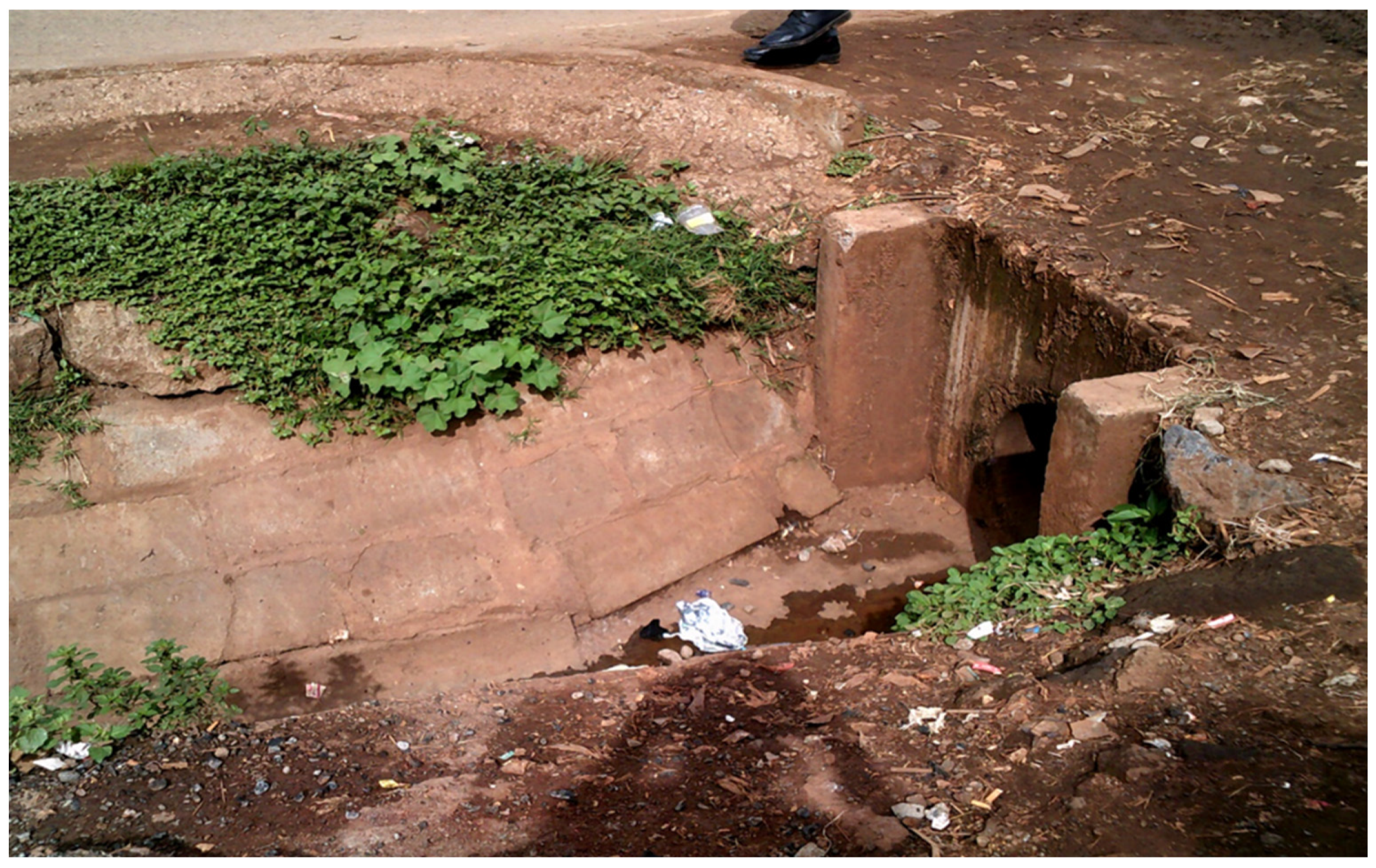
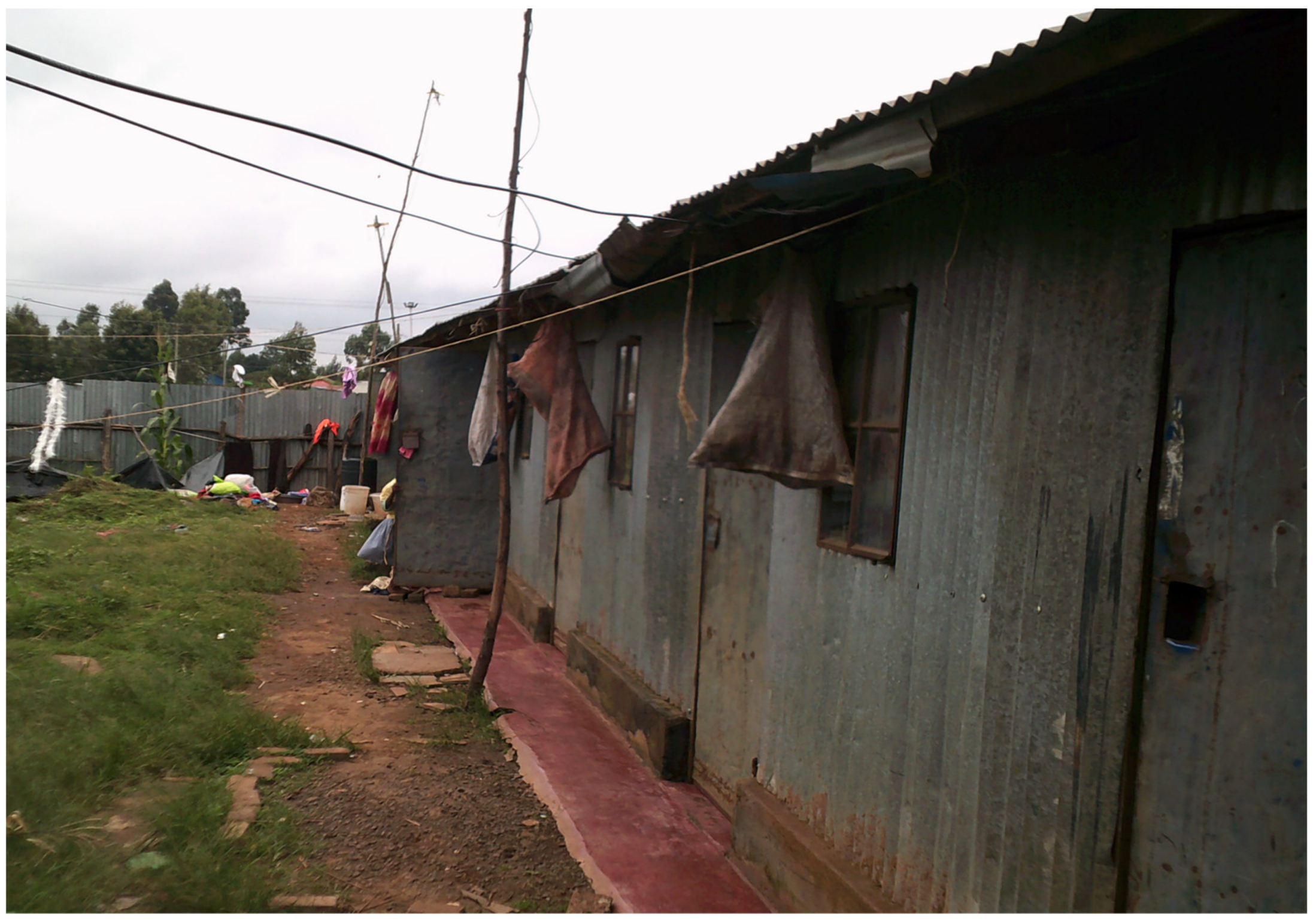
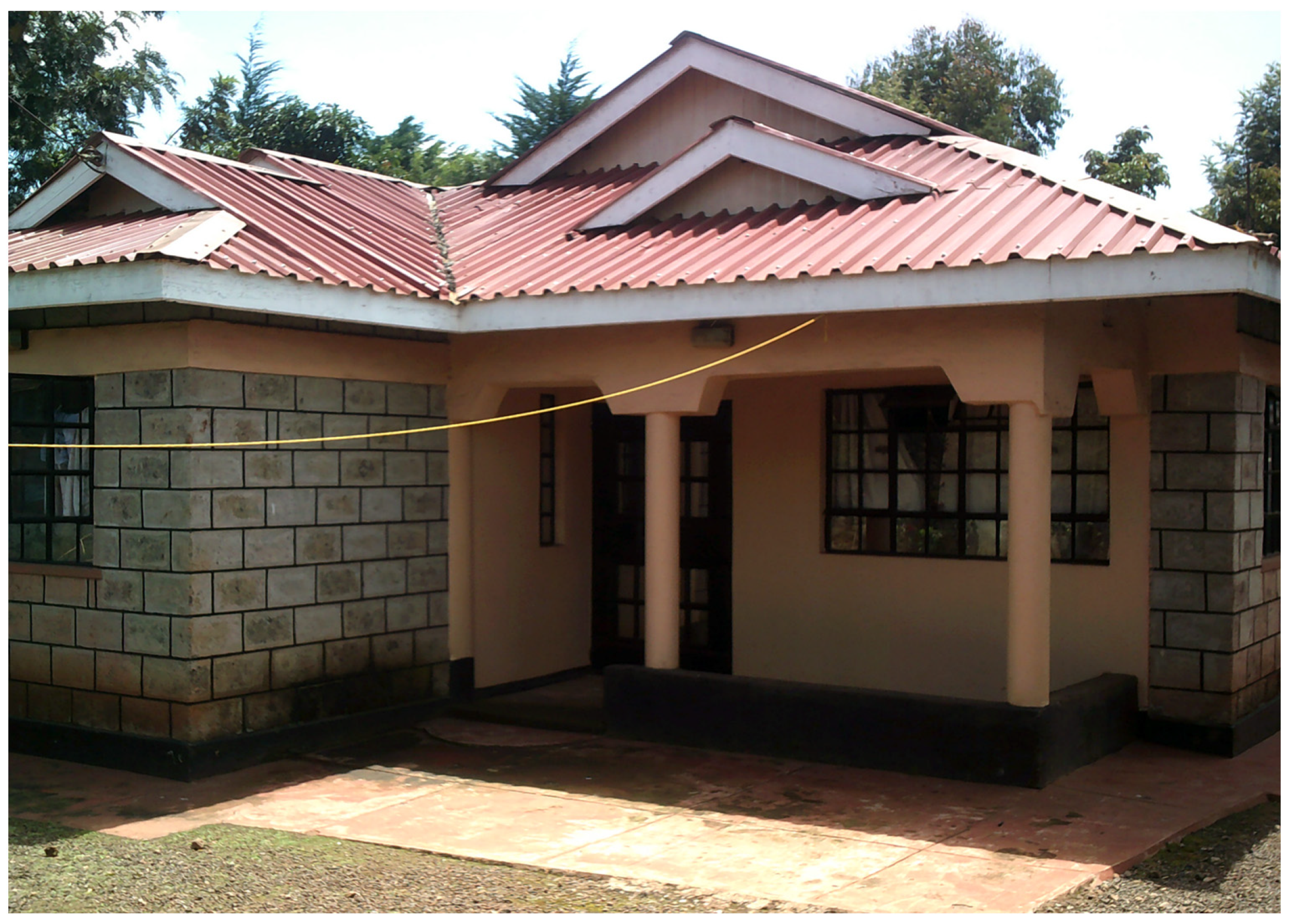
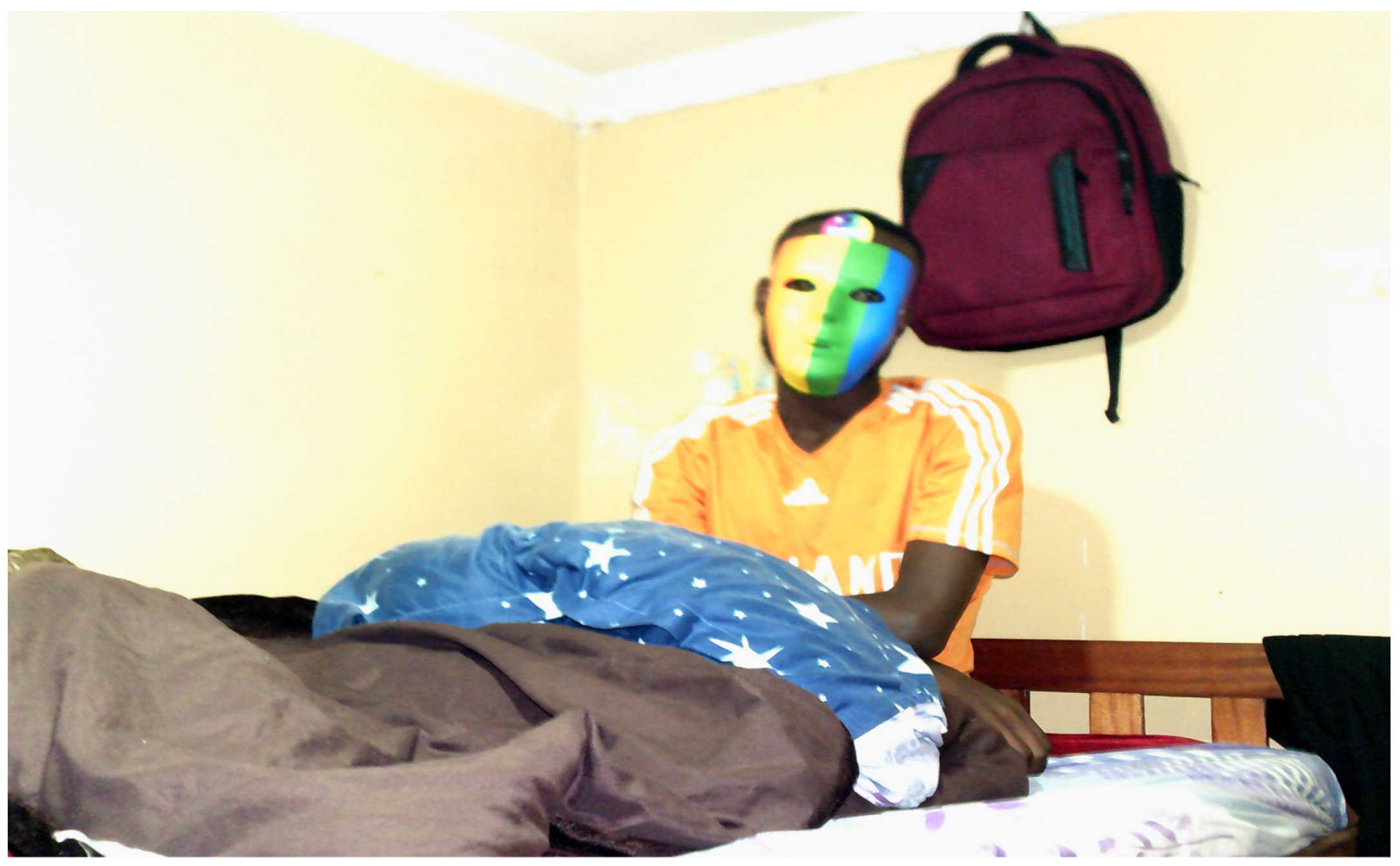
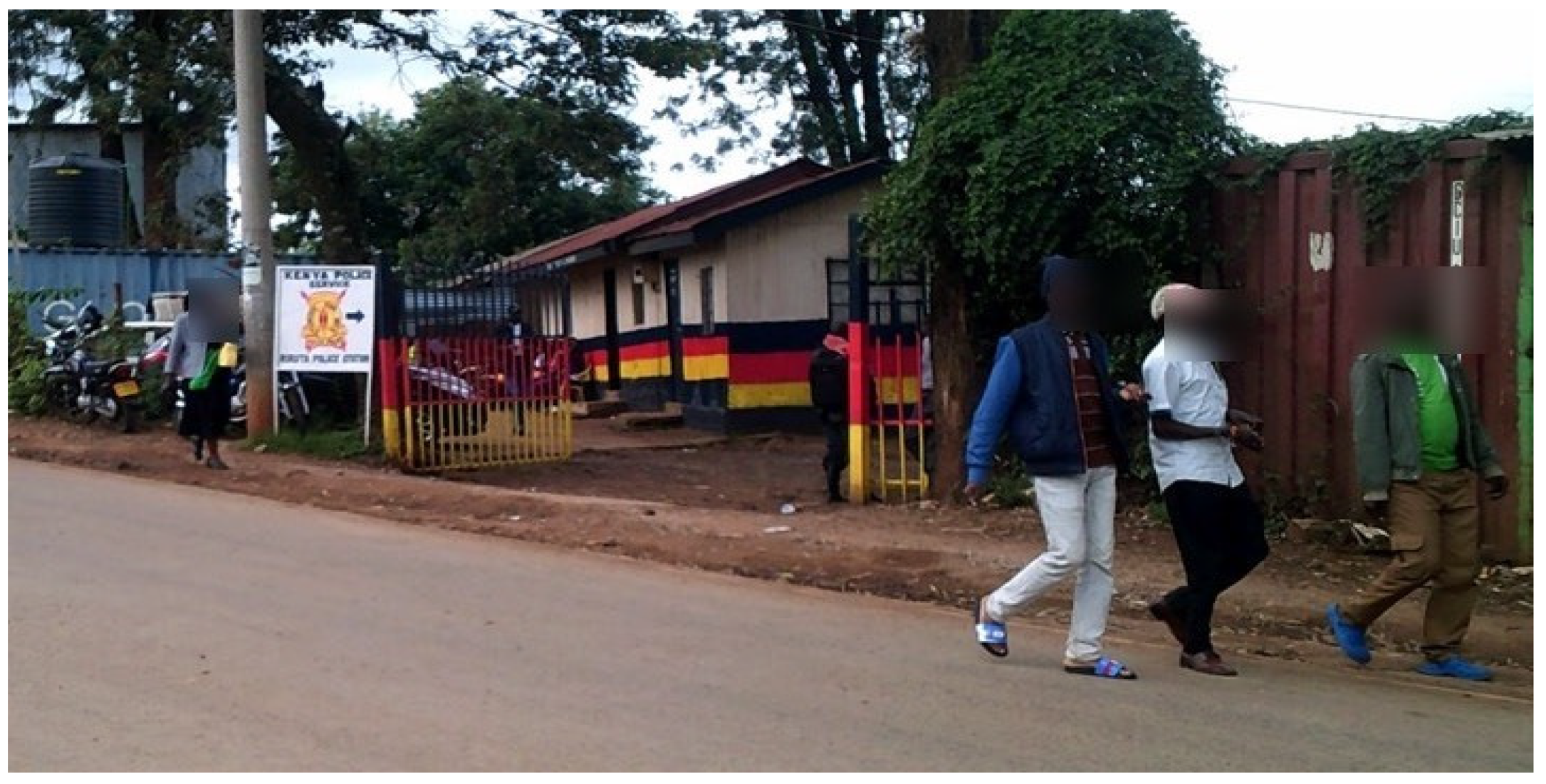
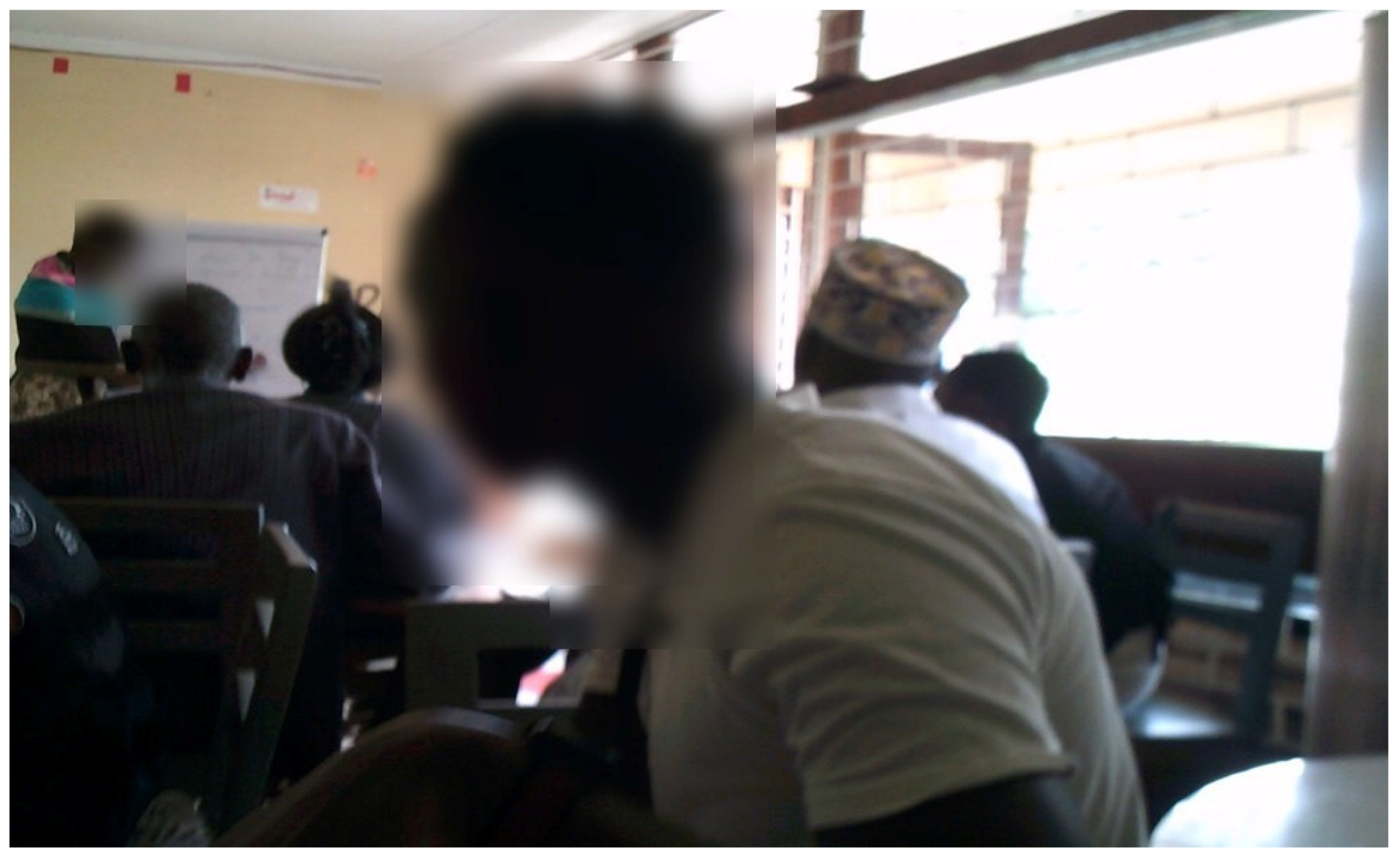

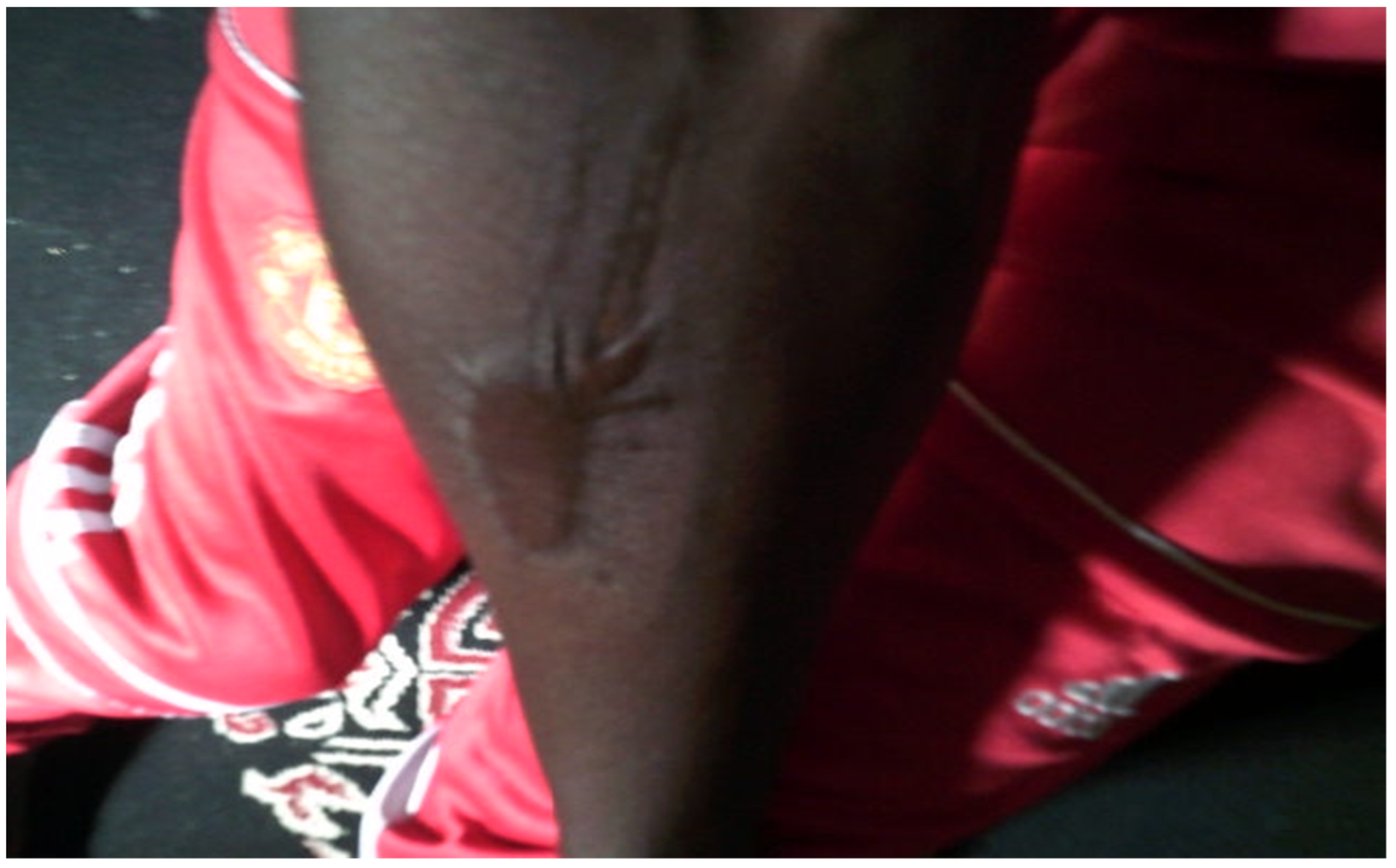

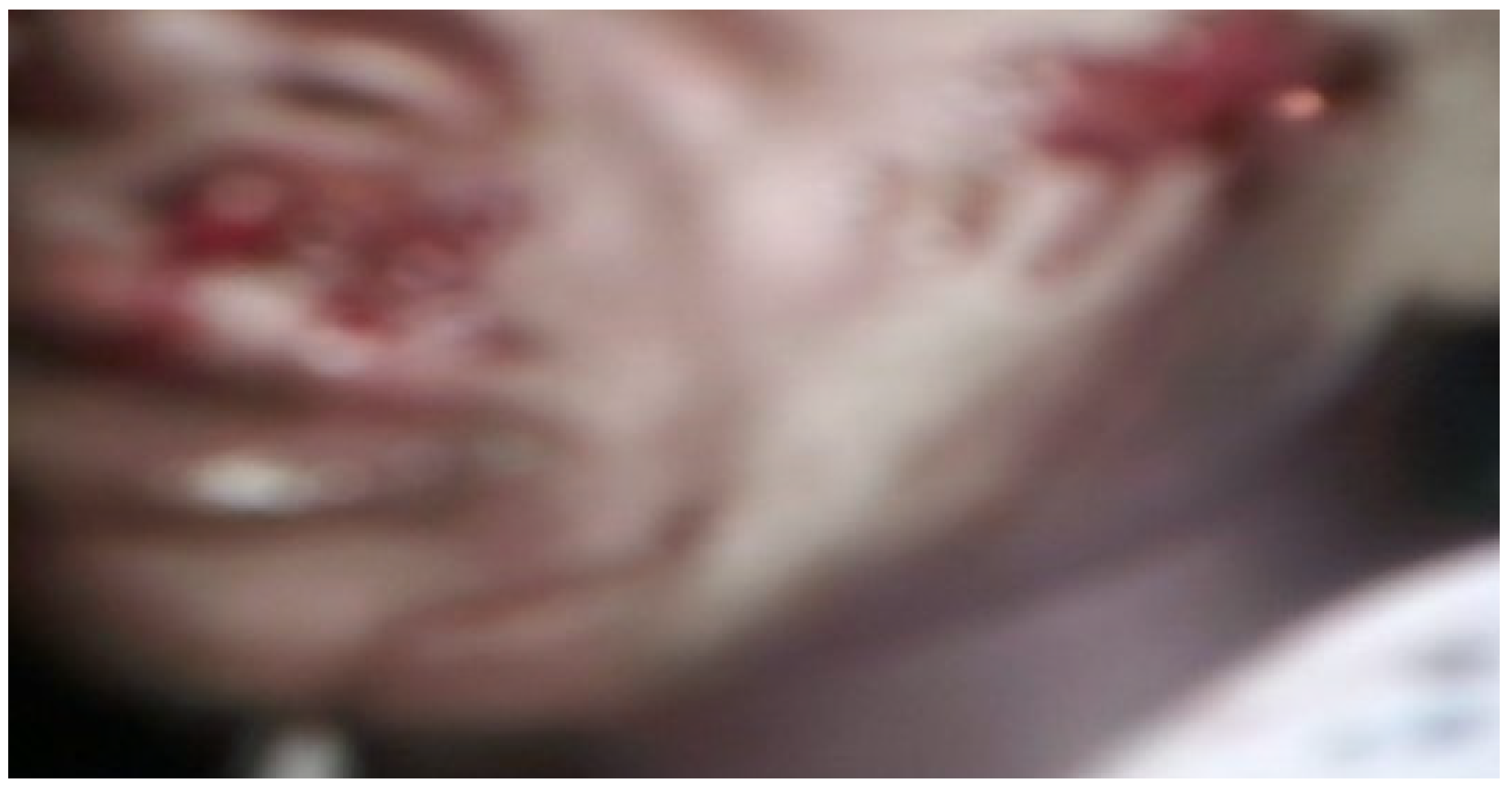
Publisher’s Note: MDPI stays neutral with regard to jurisdictional claims in published maps and institutional affiliations. |
© 2022 by the authors. Licensee MDPI, Basel, Switzerland. This article is an open access article distributed under the terms and conditions of the Creative Commons Attribution (CC BY) license (https://creativecommons.org/licenses/by/4.0/).
Share and Cite
Misedah-Robinson, L.; Schick, V.; McCurdy, S.A.; Wilkerson, J.M.; Wambua, S.; Ross, M.W. A Multi-Methodological Exploration of Persecution Experiences and Related Injuries of Sexually Minoritized Asylum Seekers and Refugees in Nairobi, Kenya. Sexes 2022, 3, 546-563. https://doi.org/10.3390/sexes3040040
Misedah-Robinson L, Schick V, McCurdy SA, Wilkerson JM, Wambua S, Ross MW. A Multi-Methodological Exploration of Persecution Experiences and Related Injuries of Sexually Minoritized Asylum Seekers and Refugees in Nairobi, Kenya. Sexes. 2022; 3(4):546-563. https://doi.org/10.3390/sexes3040040
Chicago/Turabian StyleMisedah-Robinson, Lourence, Vanessa Schick, Sheryl A. McCurdy, Johnny Michael Wilkerson, Solomon Wambua, and Michael W. Ross. 2022. "A Multi-Methodological Exploration of Persecution Experiences and Related Injuries of Sexually Minoritized Asylum Seekers and Refugees in Nairobi, Kenya" Sexes 3, no. 4: 546-563. https://doi.org/10.3390/sexes3040040
APA StyleMisedah-Robinson, L., Schick, V., McCurdy, S. A., Wilkerson, J. M., Wambua, S., & Ross, M. W. (2022). A Multi-Methodological Exploration of Persecution Experiences and Related Injuries of Sexually Minoritized Asylum Seekers and Refugees in Nairobi, Kenya. Sexes, 3(4), 546-563. https://doi.org/10.3390/sexes3040040






